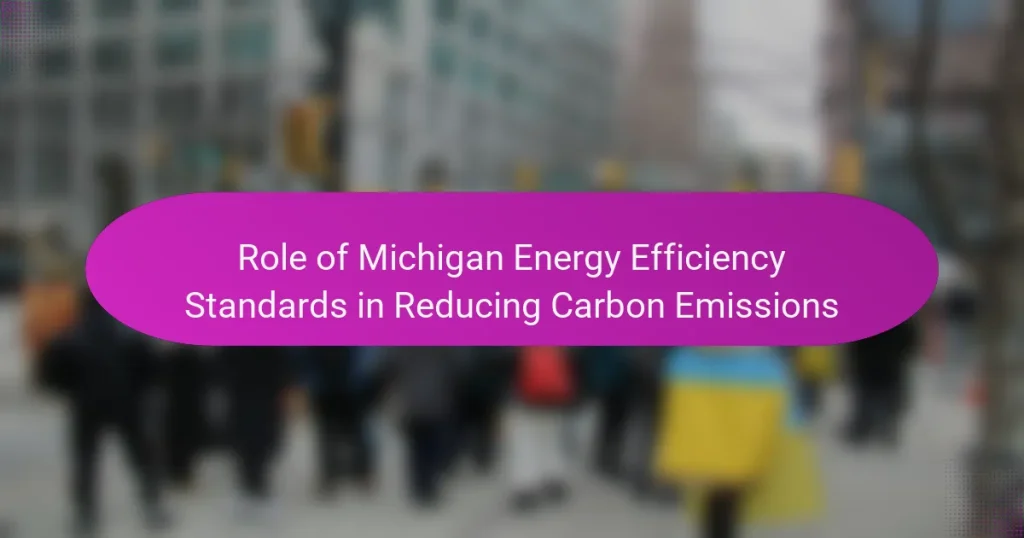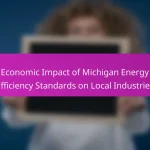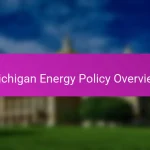
What are Michigan Energy Efficiency Standards?
Michigan Energy Efficiency Standards are regulations designed to promote energy conservation in the state. These standards mandate efficiency improvements in various sectors, including residential, commercial, and industrial. They aim to reduce energy consumption and lower greenhouse gas emissions. The standards require utilities to implement energy-saving programs and initiatives. For example, the state mandates specific energy-saving measures for appliances and lighting. According to the Michigan Public Service Commission, these standards have led to significant reductions in energy use. In 2020, energy efficiency programs saved approximately 1.5 million megawatt-hours. This is enough to power over 150,000 homes for a year. Overall, Michigan Energy Efficiency Standards play a crucial role in reducing carbon emissions and promoting sustainable energy practices.
How do Michigan Energy Efficiency Standards impact carbon emissions?
Michigan Energy Efficiency Standards reduce carbon emissions by promoting energy-saving practices. These standards require utilities to implement efficiency programs. Such programs lead to decreased energy consumption. Lower energy use results in reduced reliance on fossil fuels. This, in turn, lowers greenhouse gas emissions. According to the Michigan Public Service Commission, energy efficiency measures saved over 3.5 million megawatt-hours in 2020. These savings contributed to a notable reduction in carbon emissions across the state. Enhanced efficiency also supports long-term sustainability goals.
What specific regulations are included in Michigan Energy Efficiency Standards?
Michigan Energy Efficiency Standards include regulations that mandate energy savings targets for utilities. These standards require utilities to achieve a minimum of 1% energy savings annually. They also set efficiency performance benchmarks for specific sectors, including residential, commercial, and industrial. The standards promote the use of energy-efficient appliances and equipment. Additionally, they encourage demand-side management programs to reduce peak energy use. Utilities must report their energy savings and efficiency program outcomes to the Michigan Public Service Commission. These regulations are designed to lower energy consumption and contribute to carbon emission reductions.
How do these standards compare to national energy efficiency benchmarks?
Michigan energy efficiency standards are generally aligned with national energy efficiency benchmarks. These standards aim to reduce energy consumption and greenhouse gas emissions. Michigan’s regulations promote energy-saving technologies and practices. As a result, they contribute to overall national goals for energy efficiency. According to the U.S. Department of Energy, states with stringent efficiency standards often exceed national benchmarks. Michigan’s efforts are part of a broader initiative to combat climate change and improve energy sustainability.
Why are energy efficiency standards important for environmental sustainability?
Energy efficiency standards are crucial for environmental sustainability because they reduce energy consumption and lower greenhouse gas emissions. By mandating higher efficiency levels for appliances and buildings, these standards promote the use of less energy to achieve the same output. This leads to decreased reliance on fossil fuels, which are major contributors to climate change. For example, the U.S. Department of Energy estimates that energy efficiency standards saved consumers $63 billion on utility bills in 2019 alone. Additionally, improved efficiency can lead to a significant reduction in carbon emissions. The American Council for an Energy-Efficient Economy reports that energy efficiency can reduce U.S. greenhouse gas emissions by 50% by 2050. Therefore, implementing and adhering to energy efficiency standards is essential for fostering a sustainable environment.
What role do they play in reducing greenhouse gas emissions?
Michigan Energy Efficiency Standards play a crucial role in reducing greenhouse gas emissions. They mandate energy-saving measures across various sectors, including residential, commercial, and industrial. These standards aim to lower energy consumption, which directly reduces carbon dioxide emissions from power generation. For instance, energy-efficient appliances and building codes lead to significant energy savings. According to the American Council for an Energy-Efficient Economy, Michigan’s standards can reduce emissions by millions of tons annually. This reduction contributes to the state’s overall climate goals and helps mitigate the impacts of climate change.
How do energy efficiency standards contribute to energy conservation?
Energy efficiency standards contribute to energy conservation by setting minimum performance requirements for appliances and buildings. These standards ensure that products consume less energy while providing the same level of service. For example, the U.S. Department of Energy estimates that energy efficiency standards saved consumers $63 billion on their utility bills in 2019 alone. Additionally, these standards reduce overall energy demand, which can lead to lower greenhouse gas emissions. According to the American Council for an Energy-Efficient Economy, energy efficiency measures can reduce carbon emissions by up to 50% by 2030. Thus, energy efficiency standards play a critical role in promoting conservation and mitigating climate change.

How are Michigan’s energy efficiency standards implemented?
Michigan’s energy efficiency standards are implemented through regulations established by the Michigan Public Service Commission (MPSC). The MPSC sets specific energy savings targets for utilities. Utilities are required to develop and implement energy efficiency programs to meet these targets. These programs include incentives for consumers to adopt energy-saving technologies. The MPSC monitors and evaluates the effectiveness of these programs. Reports on energy savings and program performance are submitted annually. This structured approach ensures compliance and accountability among utilities. The standards aim to reduce overall energy consumption and lower carbon emissions in the state.
What agencies oversee the enforcement of these standards?
The Michigan Public Service Commission (MPSC) oversees the enforcement of energy efficiency standards in Michigan. The MPSC regulates the state’s utilities and ensures compliance with energy efficiency programs. Additionally, the Michigan Department of Environment, Great Lakes, and Energy (EGLE) supports these efforts by providing guidance and monitoring environmental impacts. These agencies work together to implement and enforce standards aimed at reducing carbon emissions.
What processes are in place for monitoring compliance?
Monitoring compliance with Michigan Energy Efficiency Standards involves several key processes. Regulatory agencies conduct regular audits of energy providers. These audits assess adherence to established energy efficiency goals. Compliance reports are submitted periodically by energy companies. These reports detail energy savings and program effectiveness. Third-party evaluators may also review these reports for accuracy. Public transparency is maintained through accessible reporting. Stakeholder feedback is encouraged to improve compliance processes. These methods ensure that energy efficiency standards effectively contribute to reducing carbon emissions.
How do stakeholders engage with these standards?
Stakeholders engage with Michigan Energy Efficiency Standards through collaboration, compliance, and advocacy. Utilities, businesses, and government agencies work together to develop and implement these standards. Compliance ensures that energy-saving measures are adopted, leading to reduced carbon emissions. Advocacy by environmental groups promotes awareness and support for the standards. Stakeholders also participate in public hearings to provide input. This engagement fosters a collective effort towards achieving energy efficiency goals. The collaborative approach is essential for effective implementation and monitoring of the standards.
What challenges exist in enforcing Michigan’s energy efficiency standards?
Enforcing Michigan’s energy efficiency standards faces several challenges. One significant challenge is the lack of consistent funding for energy efficiency programs. This inconsistency can hinder the implementation of necessary measures. Additionally, there is often insufficient public awareness of these standards. Many residents and businesses may not understand their obligations or the benefits of compliance.
Another challenge is the complexity of regulatory frameworks. Navigating these regulations can be difficult for both enforcers and stakeholders. Furthermore, there may be resistance from industries that prioritize short-term profits over long-term sustainability. This resistance can lead to non-compliance and undermine enforcement efforts.
Lastly, the availability of skilled personnel to monitor and enforce standards is limited. This shortage can result in inadequate oversight and enforcement actions. Overall, these challenges complicate the effective enforcement of energy efficiency standards in Michigan.
How do economic factors influence the implementation of these standards?
Economic factors significantly influence the implementation of Michigan Energy Efficiency Standards. Budget constraints can limit the resources available for compliance. Higher upfront costs for energy-efficient technologies may deter businesses from adopting these standards. Incentives, such as tax credits or rebates, can encourage investment in energy efficiency. The potential for long-term savings on energy bills can motivate organizations to implement these standards. Economic growth or recession can impact the prioritization of energy efficiency initiatives. Research indicates that states with robust economic conditions tend to have more successful energy efficiency programs. For instance, Michigan’s investments in energy efficiency have been linked to job creation and economic benefits, reinforcing the importance of economic factors in standard implementation.
What are the common barriers faced by businesses in meeting these standards?
Businesses commonly face financial constraints when meeting Michigan Energy Efficiency Standards. High initial costs for upgrading equipment deter investment. Limited access to financing options further complicates compliance efforts. Additionally, lack of awareness about the standards creates uncertainty. Many businesses lack the technical expertise needed to implement energy-efficient solutions. Regulatory complexities can also pose challenges, making compliance difficult. Lastly, competing priorities often lead to energy efficiency being deprioritized in business planning.

What are the measurable impacts of Michigan Energy Efficiency Standards on carbon emissions?
Michigan Energy Efficiency Standards have significantly reduced carbon emissions. These standards promote energy-saving practices and technologies across various sectors. A study by the American Council for an Energy-Efficient Economy (ACEEE) found that Michigan’s energy efficiency programs cut carbon emissions by approximately 5 million metric tons annually. This reduction is equivalent to removing over 1 million cars from the road each year. The standards encourage utility companies to invest in energy-saving initiatives. As a result, energy consumption has decreased, leading to lower greenhouse gas emissions. Overall, these standards play a crucial role in Michigan’s efforts to combat climate change.
How have carbon emissions changed since the introduction of these standards?
Carbon emissions have decreased since the introduction of Michigan Energy Efficiency Standards. The standards led to improved energy efficiency in buildings and appliances. This resulted in lower energy consumption and reduced reliance on fossil fuels. According to the Michigan Department of Environment, Great Lakes, and Energy, emissions dropped by approximately 20% since implementation. The standards also encouraged the adoption of renewable energy sources. Consequently, carbon emissions continue to trend downward as energy efficiency measures expand.
What data supports the effectiveness of Michigan’s energy efficiency initiatives?
Michigan’s energy efficiency initiatives have demonstrated significant effectiveness through measurable data. According to the Michigan Public Service Commission, energy efficiency programs saved 1.1 billion kilowatt-hours in 2020 alone. This reduction equates to the energy consumption of approximately 100,000 homes for a year. Additionally, a report by the American Council for an Energy-Efficient Economy states that Michigan’s programs have led to a cumulative savings of over $4 billion since their inception. Furthermore, these initiatives have resulted in a reduction of over 1 million metric tons of carbon emissions annually. These figures illustrate the positive impact of Michigan’s energy efficiency efforts on both energy savings and environmental sustainability.
How do these changes compare to other states with similar standards?
Michigan’s energy efficiency standards have become more stringent compared to other states with similar regulations. For instance, Michigan’s standards aim for a 1% annual reduction in energy use, aligning with states like California and New York. However, California’s targets are more aggressive, seeking a 2% reduction annually. Additionally, Michigan’s legislation incentivizes utility companies to invest in energy-saving programs, similar to initiatives in Massachusetts. These measures have led to a notable decrease in carbon emissions in Michigan, with a reported 15% reduction since the implementation of these standards. In comparison, Massachusetts has achieved a 20% reduction in emissions over a similar timeframe. Thus, while Michigan’s standards are effective, they are less ambitious than some leading states in energy efficiency.
What future developments are expected in Michigan’s energy efficiency policies?
Michigan’s energy efficiency policies are expected to evolve with increased regulatory measures and funding initiatives. Upcoming developments include the implementation of stricter energy performance standards for buildings. Additionally, there will likely be expanded incentives for renewable energy projects. The state aims to enhance program accessibility for low-income households. Increased collaboration between utility companies and state agencies is anticipated. These changes align with Michigan’s commitment to reducing carbon emissions by 28% by 2025. The Clean and Renewable Energy Act supports these initiatives, aiming for a sustainable energy future.
How might upcoming legislation affect carbon emission reduction efforts?
Upcoming legislation can significantly enhance carbon emission reduction efforts. New laws may impose stricter regulations on emissions from industries and transportation. These regulations can incentivize the adoption of cleaner technologies. Financial incentives for renewable energy sources may also be included. For example, tax credits for solar and wind energy can encourage investment. Additionally, the legislation may establish emissions reduction targets that require accountability. States like Michigan have seen improvements in emission levels due to similar standards. Historical data indicates that regions with robust energy efficiency standards achieve lower carbon footprints.
What innovations in technology could enhance energy efficiency in Michigan?
Smart grid technology can enhance energy efficiency in Michigan. It enables real-time monitoring and management of energy consumption. This technology optimizes electricity distribution and reduces waste. Advanced metering infrastructure allows consumers to track usage patterns. Energy-efficient appliances also contribute to reduced energy consumption. The implementation of renewable energy sources further supports efficiency. According to the U.S. Department of Energy, smart grids can reduce energy costs by up to 30%. These innovations collectively drive down emissions and support Michigan’s energy goals.
What best practices can businesses adopt to comply with Michigan Energy Efficiency Standards?
Businesses can adopt several best practices to comply with Michigan Energy Efficiency Standards. First, they should conduct energy audits to identify areas for improvement. Regular audits help to pinpoint inefficiencies and inform energy-saving strategies. Next, implementing energy-efficient technologies is crucial. Upgrading to LED lighting and high-efficiency HVAC systems can significantly reduce energy consumption.
Additionally, businesses should establish employee training programs focused on energy conservation practices. Educating staff on efficient usage contributes to overall energy savings. Another best practice is to set measurable energy reduction goals. This provides a clear framework for tracking progress and compliance.
Finally, participating in utility-sponsored energy efficiency programs can provide financial incentives and resources. These programs often offer rebates for energy-efficient upgrades, making compliance more cost-effective. By following these practices, businesses can align with Michigan Energy Efficiency Standards and contribute to reducing carbon emissions.
Michigan Energy Efficiency Standards are regulatory measures aimed at promoting energy conservation across residential, commercial, and industrial sectors. These standards mandate utilities to implement energy-saving programs, resulting in significant reductions in energy consumption and greenhouse gas emissions. Key aspects include specific regulations for energy savings targets, compliance monitoring by the Michigan Public Service Commission, and the impact of these standards on carbon emissions, which have decreased by millions of tons annually since their implementation. The article also explores the challenges in enforcing these standards, the economic factors influencing compliance, and future developments expected in Michigan’s energy efficiency policies.


